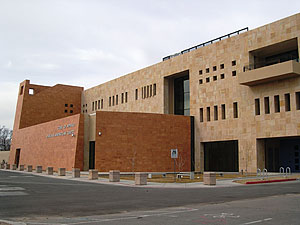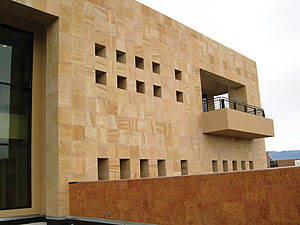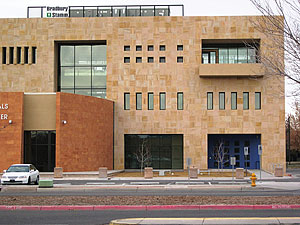
Located next door to the University of New Mexico Law School in Albuquerque, NM, the new building for the New Mexico Court of Appeals reflects the existing architecture on campus while maintaining a strong look of a government institution. A palette of Teakwood sandstone and Uxmal limestone - both supplied by MS International of Orange, CA - were chosen for the exterior design.
Photos courtesy of NCA Architects
Photos courtesy of NCA Architects
While the design intent for the new home of the New Mexico Court of Appeals was to match the architecture of its neighbor, The University of New Mexico (UNM) Law School, it was also important that the design emphasize that the structure is a government institution. To achieve just the right balance, the design team turned to a palette of sandstone and limestone - supplied by MS International, Inc. of Orange, CA - for the exterior facade.

The warm colors of the stone reflect the building’s
natural environment.
Additionally, the architectural image of the new Court of Appeals building needed to convey “New Mexico,” explained Sanchez. “The image needed to be something that is recognized - something to do with New Mexico and something that is dignified,” she said. “The court facility also was to be secure as a result of the nature of the judicial actions that take place there.”

In total, approximately 20,000 square feet of 24- x
24-inch tiles of Teakwood sandstone, which exhibit hues of yellow and orange -
was utilized for the exterior facade. The deeper rust shade of the Uxmal limestone provides
a nice contrast.
The choice of Teakwood sandstone and Uxmal limestone for the building’s exterior facade was believed to be the right decision to meet the design criteria. “One of the main reasons behind choosing the material was having the warmth and the aesthetic value of a natural stone,” said Sanchez. “Uxmal and Teakwood have an exceptional color palette that offers a warm and unique pattern that blends with the New Mexico architecture. They also complement each other and create a distinctive and timeless look.”

The exterior stone was installed with an “Exterior
Stone System” from Laticrete International of Bethany, CT.
A large portion of the exterior facade of the Court of Appeals building is clad in Teakwood sandstone - a yellowish/orange stone from India. Approximately 20,000 square feet of the material was supplied for the project, with pieces measuring 24 x 24 inches.
The Uxmal limestone, which features a deeper rust color and was quarried in Mexico., adds a nice contrast to the front of the building. Roughly 12,000 square feet of 12- x 24-inch tiles were utilized in the building’s exterior design.

Overall construction of the almost 34,000-square-foot
building took 16 months.
Due to the varying shades of color found in each stone tile, mock-ups were done prior to installing the stone, according to Sanchez, who added that the design team spent a great deal of time on site monitoring the installation. The exterior stone was installed with the “Exterior Stone System” from Laticrete International of Bethany, CT.
“The system consists of Hydro-Ban waterproofing, 254 Platinum mortar and PermaColor grout,” said Vice President Gerald Lucero of Ray’s Flooring Specialists Inc. in Albuquerque, NM, the installer for the project. “The structure was a steel frame with a cement board face. All joints were taped and bedded with the 254 Platinum mortar bed.”
According to Lucero, the most challenging aspect of the installation was the numerous windows that were designed to fit into a 24-inch modular design. “The design was based on an actual 24-inch tile, but the stone was 23 7/8 inches,” he explained. “This created a need to lay out each bank of windows individually. We had to cut or make adjustments to the joint width in order to accommodate the windows. This was made more challenging by the fact that we were not able to lay out the whole wall since the structure was only partially framed when we needed to start.”
Ray’s Flooring Specialisis Inc. began work on the stone installation in June of 2009, and it was finished in September of that same year. The install crew included five journeymen and eight to 10 apprentices. Overall, construction of the almost 34,000-square-foot building took 16 months.
“The reaction to the aesthetics and the overall building’s appearance has been outstanding,” said Sanchez. “The building has brought up a lot of interest amongst various groups of people. We have received a lot of requests for touring the building - from young architects and the New Mexico Native Plant Society to different state agencies and UNM faculty members.”
Sidebar: New Mexico Court of Appeals
Albuquerque, NMArchitect: NCA Architects, Albuquerque, NM
Stone Installer: Ray’s Flooring Specialists Inc., Albuquerque, NM
Stone Supplier: MS International, Inc., Orange, CA
Installation Products Manufacturer: Laticrete International, Inc., Bethany, CT
